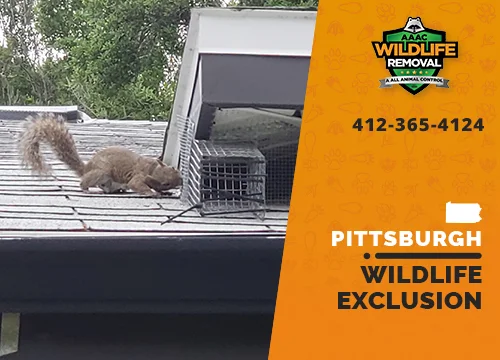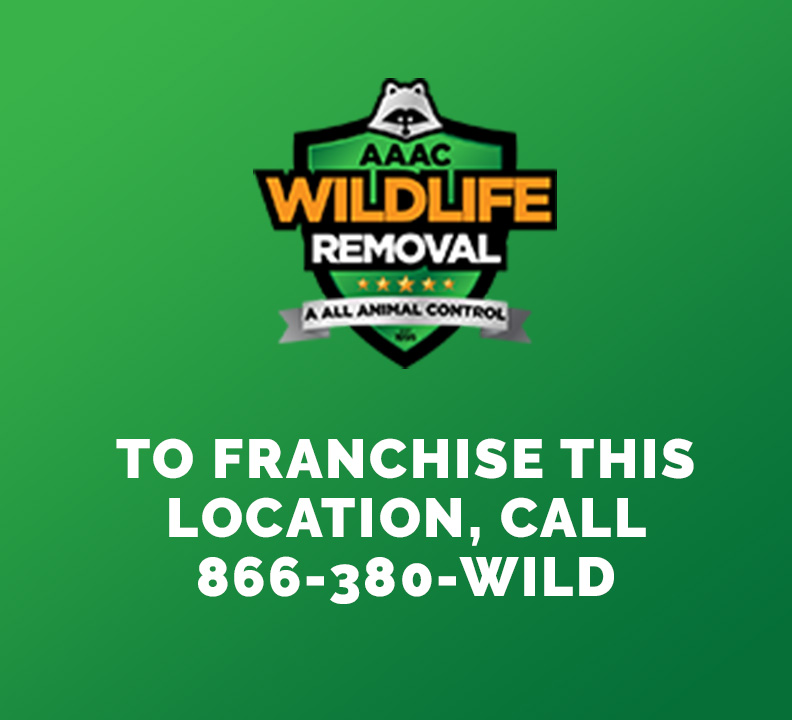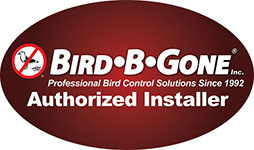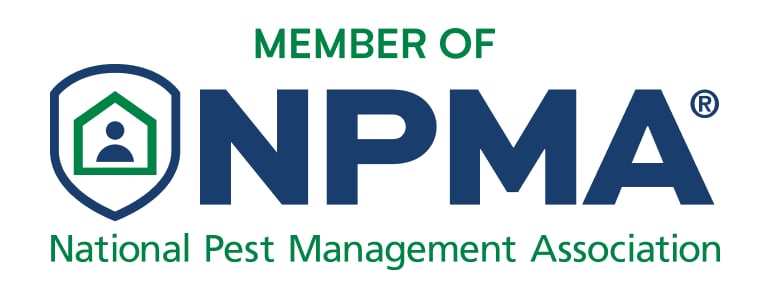
What is Wildlife Exclusion?
Exclusion is the process of sealing all animal entry points into your home or business so that they can’t get in again. This is easier than trying to exclude wildlife by yourself. You can seal all entry points so that they cannot come in.
AAAC Wildlife Exclusion Services offers humane exclusion services for any wildlife that may pose a threat to your home or business. Our exclusion experts are well-trained to safely and accurately complete the task.
We can help if you have animals living in your home or within the walls of your property. We will seal off all animal entry points that we find, including sealing holes in floors, cement cracks around pipes – basically anywhere an animal might find entry into your home or business
How We Conduct Wildlife Control and Exclusion Services
Nuisance wildlife may have somehow managed to enter your home or business, and you are now thinking about trapping and getting rid of them. But, trapping alone will not solve your problem. The first infestation might be exterminated, but without wildlife exclusion, you’re just waiting for the next one to emerge. Here are some steps to stop the infestation cycle with animal exclusion techniques.
Find and seal all entry points:
We need to find all possible entry points for animals. This might include holes in floors, cement cracks around pipes – basically anywhere an animal might find entry into your home or business. This also includes roof flashing, roof shingles, and soffits. Then, we block off any access points. Sometimes, this is done by drilling rubber grommets or metal grommets over the hole. This creates a seal. In other cases, we may use wire mesh for plugging the holes. Next, cover your hole with a waterproof covering. It will keep it safe from the elements. Lastly, we need to wait and see if there are any other openings that could lead animals inside your building before sealing them off as well.
Exclude Wildlife Using a Trap or One-Way Door
Top pest control operators will often locate the primary entrance that wild animals use to get into and out of your home or business. We deliberately leave this gap open so we can properly eliminate nuisance wildlife. Once we’ve identified it, we can use either a live trap or a one-way door.

One-way doors: If you don’t want the animal to be killed, a one-way door might be an option. These doors are designed to allow animals to enter, but not leave. To use one of these, we carefully open a hole in the door that is just big enough for the animal to fit through but too small to turn around and come back out of. We place some bait on one side of the hole, then close the door and wait for the animal. Once they head towards the bait it will be impossible for them to turn back and leave because they can’t open the door from this side!

Live traps: If you want to use live traps, set traps next to any openings outside or on the roof that animals might use. The traps can be placed near any openings that allow us to lure the animals in. This way we won’t have to deal with or see them. We will place bait inside the trap and once an animal goes inside, it’s caught! In some cases, if we are trapping wildlife of a larger size such as raccoon or opossum, we might have to set up a cage trap. It is a wire mesh trapping device that keeps the animal inside. Then technicians from our wildlife removal firm will take it out of your home.
Popular Access Points for Animal Entry
A professional wildlife pest control operator will inspect all possible access points that wildlife, including rodents, birds, bats, and rats, can use to get into your home. This will help prevent future infestations. AAAC Wildlife Removal is very thorough, but here is a quick list of the most popular access points that animals use to get inside your home.

Ridge Vents
Bats enter attics by way of the ridge vent. It is a strip of metal that runs along the roof’s edge. We can use a Ridge Guard to seal any vent openings. After the vents have been sealed, we can complete a roof repair to ensure your home is animal-proof. If you take photos of the roof, we can give you an idea of whether or not your ridge vents are open to animals.

Gable Vents
Raccoons, squirrels, or other animals often enter homes through the gable ventilations. These vents provide airflow to your attic during hot weather. They may be covered or have a small flap that can be easily pried open with an animal’s paw. We can secure these vents with a wire mesh. This allows for airflow but does not allow animals to enter. We can also repair any damage to the vent flaps or replace any wood that has become rotted.

Dryer Vents
Dryer vents offer rodents and birds a convenient entry point. Rodents will often chew their way into your home using these vents if they find themselves migrating from one building to the next looking for food or shelter. Dryer vents provide enough airflow to keep them alive. Therefore, it is crucial that we seal the vents and secure any openings with metal mesh.
The warm airflow that flows through dryer vents is what birds like. You might notice an increase in your electricity costs as birds use the dryer vents as access for their nesting areas. The best prevention is the installation of common vent guards.

Soffit
Squirrels and raccoons love getting into your attic through a damaged soffit. Wildlife removal professionals should remove any decayed wood that allows wildlife access and seal the gaps with metal mesh or closures. Your soffit can look brand new again and the rodent family will be gone forever.

Fascia
The fascia of the house is another favorite spot for wild animals. If your roof had gutters, the fascia would cover the gutter under your roof. It’s a longboard that covers up any gap between where the roof begins and where your eaves begin. To stop wildlife from using the access point, we seal all gaps with metal mesh, replace any rotten wood, then cover it with a metal covering that allows water to flow freely but prevents animals from entering.

Eaves
Raccoons love to climb up your roof through the eaves. The edges of your roof that meet the sides of the house are called eaves. To keep wildlife out, our technicians can use metal mesh to close any gaps. Or, we can install special guards that prevent animals from entering.

The Chimney
The chimney is a common way for animals to enter a house. If bats are already inside the chimney, we can remove and replace the chimney liners to get rid of the animals and prevent them from getting back in.
Bats, squirrels, raccoons, and other small animals love to rest in the chimney. This is an access point that is hard to check because of fire hazards and venting. Flameless heat detection cameras are often used to locate animals’ hiding places. We can also remove old caps and remove the liner to replace them.

Cracks in the foundation
Foundation cracks are a favorite entry point for rodents. We can fill foundation cracks with cement filler compounds to keep rodents out of your home. This repair is animal-proof and will make your home look great from the outside.

Exposed pipes
Exposed pipes are the perfect way for rodents of all kinds to enter your house. You can prevent this by covering up any openings with metal mesh. Then, cover them with a cap that allows air to circulate freely through your home.

Wildlife Damage Repair Service
After you have completed your wildlife exclusion, it is important to repair any damage that rodents/squirts, bats/birds, rodents/rats, mice, rats, or other pests may cause. Most wild animals will make their doorway into your home larger by gnawing at it with their teeth or scratching at it with their claws. Some of the damage can be quite ugly.
Our wildlife damage repair services are top-notch among pest control providers. We have the skills and experience required to repair any form of wildlife damage. Our contractors have the ability to replace damaged drywall and insulation. The contractors have the skills to quickly and efficiently repair your home to minimize future animal damage.
Learn more about Wildlife Damage Repair

Attic Restoration
An infestation could cause your attic to be contaminated with blood, urine, and feces. This can cause a horrible stench and create a perfect environment for mold growth. Our pest control experts will replace any contaminated insulation with fresh materials that have been treated against humidity and odor. We can replace insulation that has been chewed up by pests like rats, mice, and squirrels with new material attached to the floor with heavy-duty staples. Attics will look like new again with our attic restoration service!
Learn more about Attic Restoration
Wild Animal Pest Control
Exclusion is an effective method of controlling wildlife pests. Wildlife can be humanely trapped or encouraged to go. Once their home has been sealed, they will not be able to come back in. This article provides information about a professional wildlife exclusion service that resolves the problems caused by wild animals. AAAC Wildlife Removal provides expert wildlife exclusion services.










